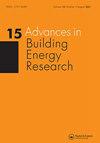Grey Wolf algorithmic framework for building energy optimization in India's Köppen-Geiger climatic zones
IF 2.5
Q2 CONSTRUCTION & BUILDING TECHNOLOGY
引用次数: 0
Abstract
ABSTRACT Grey Wolf Optimization (GWO) is an emerging evolutionary metaheuristic technique capable of solving challenging engineering problems. Despite its growing popularity, GWO's suitability for building design problems remains unexplored. This paper presents a novel algorithmic framework using EnergyPlus, EPLauncher and Matlab to implement a single and bi-objective GWO for building energy optimization. The goal is to identify optimal wall and window type, orientation, air conditioner's operational profiles and cooling setpoints consistent with minimum annual and peak cooling energy demands for a residential apartment building in five Köppen-Geiger climate zones across India. In place of testing the entire parametric space involving 5,76,000 possibilities, GWO identifies the optimal solutions inside 1250 trials (∼99% run reduction). The single and bi-objective GWO produces (83-97)% and (75-95)% annual and peak cooling demand reductions than a typical construction and operation scenario in the five climate zones. The optimized solutions recommend low thermal transmittance-high capacitance wall sections, 10–15% window-to-wall ratios and double glazed windows with a low solar gain coefficient. Further, optimal air conditioner operational parameters (setpoint and duration) are identified. The presented algorithmic framework is highly robust and can integrate can incorporate upcoming metaheuristic algorithms to perform single and multiobjective building energy optimizations.印度Köppen-Geiger气候带建筑能源优化的灰狼算法框架
灰太狼优化(GWO)是一种新兴的进化元启发式技术,能够解决具有挑战性的工程问题。尽管GWO越来越受欢迎,但它对建筑设计问题的适用性仍未得到探索。本文提出了一种新的算法框架,使用EnergyPlus、EPLauncher和Matlab来实现用于建筑能源优化的单目标和双目标GWO。目标是为印度五个科彭-盖革气候区的住宅公寓楼确定最佳的墙壁和窗户类型、方向、空调的运行状况和冷却设定值,以满足最低年度和峰值冷却能源需求。GWO在1250次试验中确定了最佳解决方案(约99%的运行减少),而不是测试涉及57600种可能性的整个参数空间。与五个气候区的典型施工和运营情景相比,单目标和双目标GWO每年和峰值制冷需求分别减少(83-97)%和(75-95)%。优化的解决方案建议采用低热透过率、高电容的墙截面、10-15%的窗墙比和具有低太阳能增益系数的双层玻璃窗。此外,确定了最佳空调运行参数(设定点和持续时间)。所提出的算法框架具有高度鲁棒性,可以集成即将到来的元启发式算法来执行单目标和多目标建筑能量优化。
本文章由计算机程序翻译,如有差异,请以英文原文为准。
求助全文
约1分钟内获得全文
求助全文
来源期刊

Advances in Building Energy Research
CONSTRUCTION & BUILDING TECHNOLOGY-
CiteScore
4.80
自引率
5.00%
发文量
11
 求助内容:
求助内容: 应助结果提醒方式:
应助结果提醒方式:


